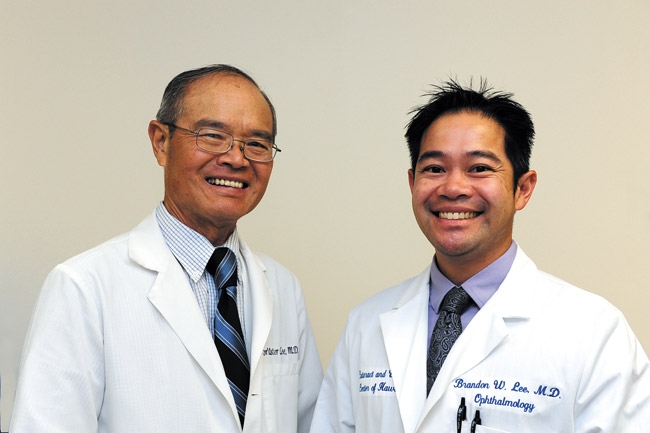The Latest In Laser Eye Surgery
Where did you receive your schooling and training?
Worldster: I attended Northwestern University Medical School and completed my residency training at University of Missouri in Kansas City. I then performed a two-year fellowship in retina surgery at the Massachusetts Eye and Ear Infirmary in Boston.
Brandon: I obtained my bachelor’s degree from UCLA and graduated from Harvard Medical School. I completed my residency training in ophthalmology at University of Southern California and finished with a fellowship in medical diseases of the retina at Bascom Palmer Eye Institute in Miami.
How long have you been in practice?
Worldster: I have been practicing here in Hawaii for more than 30 years now.
Brandon: I moved home to join the practice two years ago.
What is a cataract?
Brandon: A cataract is a clouding of the eye’s natural lens that generally occurs with age, typically around the age of 60 or later. It’s something that everyone will eventually develop as they get older.
Can you talk about the newest cataract surgery technology?
Brandon: The Catalys laser is one of the newest lasers to become available for use in cataract surgery. It performs the key steps of cataract surgery in an automated fashion so that it’s very precise, more precise than is generally achievable by hand. It also corrects astigmatism, the irregular shape of the eye, giving patients better vision without glasses.
How long does the laser procedure take?
Brandon: We first perform the laser treatment, which takes about three minutes, on average. The patient is still awake, but sedated and comfortable. Then, we take the patient into the operating room, where we remove the cataract, which has already been softened by the laser. This makes the surgery easier and more gentle on the eye. That usually takes on average 10-15 minutes. The entire procedure is about 20 minutes long. We have an on-site outpatient surgery center dedicated to cataract surgery, so patients do not need to go to the hospital for surgery.
The machine is brand new. We were the first in Hawaii to acquire the Catalys laser. The technology has been around for about two years.
How does the Catalys laser compare to traditional cataract surgery?
Worldster: In both cases, the surgery involves removing a cloudy lens from the eye and replacing it with a clear intraocular lens implant. The Catalys laser allows for safer and more efficient removal of the cataract and more precise placement of the lens implant.
Brandon: Laser cataract surgery generally has a faster recovery time, resulting in clear vision sooner after surgery, and reduces the risk of complications during surgery.
Does the surgery lessen the need for glasses?
Brandon: Most patients usually require glasses after cataract surgery, either for reading or distance, or sometimes both. Laser cataract surgery helps correct astigmatism, reducing your need for glasses after surgery.
Worldster: We also offer a multifocal lens implant, which allows patients to see both distance and up close without glasses. It has become increasingly popular with those people who don’t want to have to wear reading glasses or bifocals anymore. The multifocal lens is not covered by insurance, so there is an additional fee for that service.
Dr. Worldster, you have the interesting distinction of having treated former Philippine President Ferdinand Marcos.
Worldster: Yes, I had the privilege of taking care of him and doing his cataract surgery. He was very grateful. My two sons were fairly young at that time, but they came and had their picture taken with him.
What does your other son do? Will he be joining the family business?
Worldster: My younger son Bradford already has completed his residency in ophthalmology and is currently doing his sub-specialty training in oculoplastic surgery in San Diego. He most likely will return to practice with us in the next few years.






